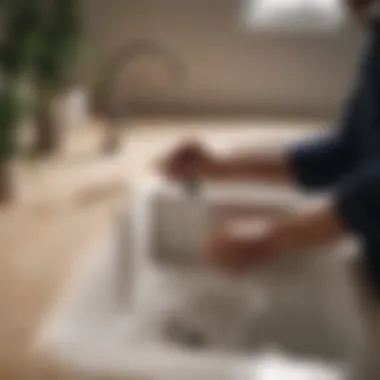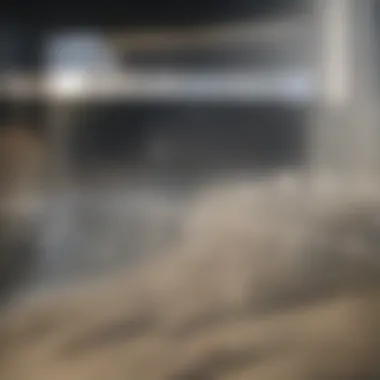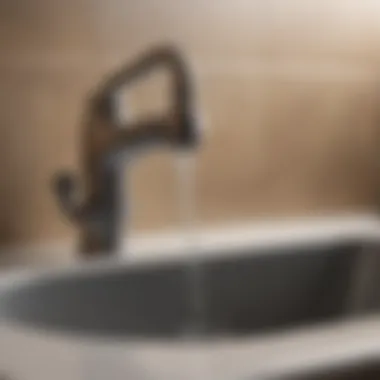DIY Drain Declogger: Eco-Friendly Solutions for Home


Intro
Clogged drains are a common problem for homeowners, often arising from everyday activities like cooking and bathing. While calling a plumber might seem like the straightforward solution, many homeowners can effectively resolve this issue using DIY methods. This guide goes deep into various techniques to declog drains, utilizing everyday ingredients and eco-friendly solutions that anyone can apply.
By understanding the roots of clogs and learning how to maintain plumbing health, homeowners can save time and money. The following sections will unfold practical instructions, preventive measures, and insights into effective methods to keep drains flowing smoothly.
Common Causes of Clogs
Before delving into the solutions, it's necessary to identify what typically leads to clogs in the first place. Here are some common causes:
- Food debris: Bits of food can accumulate in kitchen sinks over time.
- Hair: Often the primary culprit in bathroom drains.
- Soap residue: Soap scum can build up, especially in showers and tubs.
- Mineral buildup: Hard water can lead to deposits that narrow pipes.
Understanding these common issues helps inform the DIY solutions that follow.
Eco-Friendly Solutions
Choosing environmentally friendly methods not only declogs drains effectively but also contributes to a healthier home. Below are some techniques that rely on common household items:
Baking Soda and Vinegar
One of the most popular methods involves mixing baking soda with vinegar. The chemical reaction between these two creates a fizzing action that can help break down minor clogs. Here's how to use this technique:
- Pour half a cup of baking soda down the drain.
- Follow with half a cup of vinegar.
- Cover the drain for 15-30 minutes to allow the mixture to work.
- Flush with hot water.
Salt and Hot Water
Salt can serve as a dehydrating agent, which helps break down clogging materials:
- Pour a handful of salt down the drain.
- Immediately follow with hot water, not boiling, as it may damage pipes.
- Wait a few minutes and repeat if necessary.
Preventive Measures
Even the best DIY methods may be for naught without proper preventive care. Here are some tips to maintain drain health:
- Use strainers: Simple mesh screens can catch food and hair before they go down the drain.
- Regular maintenance: Establish a routine cleaning schedule, perhaps monthly, to prevent buildup.
- Avoid harsh chemicals: They can harm plumbing and the environment. Instead, opt for the natural methods outlined above.
"Regular maintenance is key to maintaining optimal plumbing health."
Summary
Understanding the causes and solutions for clogged drains equips homeowners with the knowledge to tackle problems head-on. By using simple ingredients, applying effective methods, and maintaining a preventive approach, it is absolutely possible to keep your drains functioning well. In the following sections, we will explore each solution in detail, presenting practical steps and intricate methods for maintaining your plumbing system without reliance on commercial products.
Understanding Drain Blockages
Drain blockages are a pervasive issue faced by homeowners. Understanding these blockages is crucial for effective DIY declogging, which negates the need for commercial products. Grasping the fundamental causes and types of drains impacted can simplify the maintenance of a household's plumbing system. A clear comprehension helps paint a complete picture, allowing homeowners to engage thoughtfully in preventative measures and solutions.
Common Causes of Drain Clogs
Drain clogs can stem from various sources, often combining to create significant blockages. The most common causes include:
- Hair: A usual suspect, especially in bathroom sinks and showers. Hair entangles with soap and grease, forming stubborn clumps.
- Grease: Cooking grease and fats can solidify in pipes over time, leading to thick accumulations.
- Food Waste: In kitchen sinks, food particles can gather and contribute to clogs, especially when flushed down without proper disposal methods.
- Soap Residue: Soap can combine with minerals in water, forming soap scum that sticks to the walls of pipes.
- Foreign Objects: Items not intended for drainage can inadvertently cause issues. This includes toys, cotton balls, or excessive paper products.
Understanding these causes allows homeowners to tackle problems before they escalate, reducing the frequency of major clogs.
Types of Drains Affected
Different drains in a household can experience blockages, each requiring distinct approaches to remedy. The primary types of drains affected include:
- Kitchen Drains: These face grease and food scraps regularly. Clogs here can lead to foul odors and slow drainage.
- Bathroom Drains: Mostly affected by hair and soap scum, bathroom drains often need specific maintenance.
- Toilet Drains: Blockages in toilets can be due to improper items being flushed. This may lead to severe issues requiring professional assistance.
- Utility Room Drains: Drainage systems in laundry rooms can accumulate lint and fabric remnants, leading to additional clogs.


Being aware of which drains are more susceptible to blockages enables homeowners to implement effective strategies to maintain their plumbing systems.
The Importance of Eco-Friendly Solutions
In an age where environmental awareness is paramount, the significance of eco-friendly solutions cannot be overstated. This article’s focus on sustainable DIY drain declogging methods seeks to empower homeowners to manage plumbing issues while being conscientious of the planet. The advantage of utilizing natural products over chemical cleaners extends beyond mere convenience, offering benefits that affect health, safety, and the ecological balance. Understanding these eco-friendly alternatives enhances not only plumbing maintenance but also contributes to broader environmental goals.
Environmental Impact of Chemical Cleaners
Chemical drain cleaners, often laden with harsh substances, can have a detrimental effect on both human health and the environment. Many of these products contain toxic ingredients, which can lead to concerns such as skin irritation or respiratory problems upon exposure. Furthermore, when these chemicals are washed down the drain, they can enter watershed systems, polluting rivers and streams, affecting aquatic ecosystems, and potentially harming wildlife.
The wastewater treatment process is not foolproof; some chemicals may not be adequately removed, leading to long-term soil contamination. Additionally, the production and transportation of these chemical cleaners consume fossil fuels, contributing to greenhouse gas emissions. Recognizing the extensive impact, it is essential to consider safer alternatives that minimize this environmental footprint.
"Using natural solutions not only protects your home but also safeguards the planet for future generations."
Benefits of Non-Toxic Alternatives
Non-toxic alternatives present a multitude of benefits, making them an effective choice for homeowners seeking to declog drains responsibly. First, these ingredients, often found in everyday household supplies, are generally safe to handle. Simple mixtures of vinegar, baking soda, and salt can achieve remarkable results without the harmful side effects associated with commercial cleaners.
The positive aspects of using eco-friendly solutions include:
- Safety: Less health risk from exposure to toxic substances.
- Cost-Effective: Household items are often more affordable and accessible.
- Biodegradability: Non-toxic substances break down naturally, reducing their impact on the environment.
- Effectiveness: Many natural ingredients are surprisingly effective against common clogs.
By choosing non-toxic methods, homeowners contribute to a healthier home environment while encouraging sustainable practices. This shift not only addresses immediate plumbing concerns but fosters a sense of responsibility towards the planet.
Household Ingredients for Declogging Drains
The use of household ingredients for declogging drains is a vital area in the home maintenance realm. These methods are often accessible, inexpensive, and environmentally friendly. Understanding how to utilize what is already in your home simplifies the process of dealing with clogged drains. Furthermore, avoiding harsh chemical solutions can significantly reduce the environmental impact of our daily activities. Homeowners seeking efficient yet safe options will find household ingredients valuable and effective.
Baking Soda and Vinegar Mixture
Baking soda and vinegar form a classic duo in declogging science. This combination creates a chemical reaction that effectively dislodges debris. To implement this method, start by pouring one cup of baking soda directly into the drain. Follow this promptly with a cup of vinegar. Cover the drain to keep the fizz contained, allowing the reaction to work for about 30 minutes. The visual and audible sign of bubbling indicates the remedy’s effectiveness. After the waiting period, rinse the drain with hot water for better results. This method is not only effective but also ensures no toxic residues remain after cleaning.
Salt and Hot Water Method
Salt mixed with hot water presents another straightforward alternative. The salt acts as a natural abrasive, assisting in breaking down blockages in the pipes. Start by boiling approximately two liters of water. Once boiling, add half a cup of salt and stir until the salt dissolves entirely. Slowly pour this solution down the drain. Allow it to sit for several minutes to work through the clog. It is advisable to follow this treatment with a fresh round of hot water. This extra step helps flush out any residual material that may still stick to the pipes. Use this method regularly to maintain optimal drain flow.
Dish Soap with Boiling Water
Dish soap often contains detergents that can aid in breaking down grease and grime buildup. For this method, pour a generous amount of dish soap down the drain. Then, proceed by carefully pouring boiling water on top of it. The heat combined with the soap should help dissolve thicker grease. This method is particularly effective for kitchen sinks plagued with greasy clogs. It may require a few cycles of applying soap followed by hot water for stubborn blockages. Overall, combining domestic dish soap with boiling water stands out as a quick solution for common clogs.
Effective use of household ingredients not only saves money but also maintains ecological integrity.
By incorporating these household remedies, individuals can tackle drain issues effectively while also promoting sustainable practices.
Tools for Effective Drain Cleaning
Effective drain cleaning requires the right tools to efficiently address blockages and maintain plumbing health. Using appropriate instruments not only speeds up the declogging process, but it also minimizes potential damage to pipes. This section highlights critical tools essential for tackling drain issues effectively, focusing on benefits and the context of their usage in household application.
Having the proper tools can make the difference between a frustrating experience and a successful declogging attempt. Homeowners must be aware of what tools they may need and when to deploy them.
Plumber's Snake: When and How to Use
The plumber's snake, also known as a drain auger, can be an invaluable tool when conventional methods fail. It is specifically designed to reach deep into pipes and remove stubborn blockages. Understanding when to use a plumber's snake is crucial to avoid further complications.
Typically, the need arises when you feel resistance in the drain or when water refuses to flow, even after attempting other methods. Here’s how to use it effectively:
- Insert the end of the snake into the drain. Rotate the handle in a clockwise direction. This action encourages the snake to navigate through the pipes.
- Push gently until resistance is met. This usually indicates that you have reached the clog.
- Rotate and advance the snake. This will help break up or grasp the blockage effectively.
- Withdraw the snake slowly, bringing any debris with it. Repeat as necessary.
Some tips to remember include:


- Always wear gloves and protective eyewear while using the snake.
- Be cautious to avoid damaging your plumbing when applying too much force.
Wet/Dry Vacuum for Quick Solutions
A wet/dry vacuum is a versatile tool that can provide quick solutions to unclogging tasks. It serves as a powerful ally, particularly for situations that involve liquid blockages or large debris.
Here’s when and how to effectively use a wet/dry vacuum:
- Select the appropriate setting on the vacuum for liquid cleaning, if applicable.
- Create a seal around the drain. You may use a rag or a specially designed attachment to ensure a tight fit to maximize suction.
- Activate the vacuum. The strong suction will pull debris out of the pipe, often dislodging clogs in the process.
- Clean the vacuum filter and container afterward to maintain its efficiency.
A few considerations include:
- Ensure the vacuum you use is suitable for both wet and dry applications.
- This method may not reach deep blockages effectively, but it can handle visible clogs in sinks and showers efficiently.
Effective tools not only enhance the declogging process but also ensure that plumbing systems remain in good health over time.
Step-by-Step Guide to DIY Drain Declogging
DIY drain declogging is a necessary skill for homeowners. It empowers individuals to address plumbing issues without immediately calling a plumber. Understanding how to effectively declog drains can save both time and money. Moreover, knowledge in this area promotes sustainable practices by relying on household ingredients and simple tools rather than harsh chemicals.
Preparation: Safety and Materials
Before undertaking any drain declogging task, proper preparation is crucial. Safety should always be the first concern. It is advisable to wear gloves to protect your hands from any bacteria or debris found in the drain. Eye protection is also recommended when using certain methods, like the plumber's snake.
Materials Needed:
- Baking soda
- Vinegar
- Salt
- Hot water
- Dish soap
- Plumber's snake
- Wet/dry vacuum (optional)
Gathering these materials ensures a more efficient process. Each ingredient has specific properties suited for different types of clogs. For example, baking soda and vinegar work well for organic materials, while salt can help dissolve stubborn build-ups.
Applying the Chosen Method
Once prepared, the next step involves applying the selected declogging method. Each method has distinct characteristics. Using the baking soda and vinegar mixture is a popular choice. Pour half a cup of baking soda down the drain, followed by half a cup of vinegar. Cover the drain to contain the reaction and wait for about 30 minutes. Afterward, flush with hot water. This method unblocks and cleans the drain efficiently.
Another effective technique involves using salt and hot water. Pour a cup of salt down the drain, followed by boiling water. This combination can help break down grease and other debris.
When clogs are severe, a plumber's snake may be necessary. Insert it into the drain and twist gently to break apart the blockage. If accessible, a wet/dry vacuum can also serve to suck out the clog if it’s near the top of the pipe.
Post-Cleaning Maintenance Tips
After successfully declogging the drain, maintenance plays a crucial role in preventing future issues. Regularly flushing the drain with hot water can help keep it clear of build-ups. Moreover, it’s wise to pour a mixture of baking soda and vinegar down the drain monthly as a preventative measure.
Also, practicing safe disposal habits is essential. Avoid letting grease, coffee grounds, or large food particles go down the drain. Educating family members on proper disposal habits is beneficial as well.
Regular maintenance can significantly extend the life of your plumbing system.
Engaging in these routines helps maintain good plumbing health and reduces the likelihood of clogs reappearing. By incorporating these preventative measures, homeowners can manage their drains more effectively.
Preventative Measures for Clogs
Preventing clogs is often overlooked in drain maintenance. This section will explore why preventative measures are vital. They save both time and money. Clogs can lead to complex plumbing issues that result in costly repairs. By incorporating simple habits, homeowners can greatly reduce the risk of clogs.
Regular maintenance is not just about cleaning; it involves keeping an eye out for problems before they escalate. Natural materials like hair, grease, and food particles can accumulate over time. Even minor clogs can grow into major inconveniences if neglected. Adequate preventative steps encourage plumbing systems to function effectively. It is also better for the environment.
Applying proactive measures enables homeowners to maintain healthy plumbing systems. Here are some practices that can be easily integrated into everyday life:
- Regularly inspect drains for any signs of slow water flow.
- Use drain covers to catch hair and debris.
- Run hot water down the kitchen sink after using it to dissolve grease.
- Limit food waste going down kitchen drains.
Implementing these habits helps keep drains clear and functional.


Regular Maintenance Practices
Regular maintenance is the cornerstone of effective prevention against clogs. It involves simple yet consistent actions that can make a significant difference. Here are some suggested practices:
- Routine Cleaning: Schedule a regular cleanout of kitchen and bathroom drains. Using a mixture of baking soda and vinegar can keep the drains clean without harsh chemicals.
- Check for Leaks: Inspect pipes especially under sinks. Small leaks can lead to corrosion and sediment buildup, eventually causing clogs.
- Use a Drain Strainer: Place a strainer in kitchen sinks to prevent food scraps from getting washed down the drain. This easy addition reduces debris accumulation.
By regularly engaging in these practices, you can ensure your drains remain clear and functioning.
Education on Proper Disposal of Waste
Educating oneself on proper waste disposal is essential to preventing clogs. Homeowners often underestimate the impact of improper waste disposal. Basic information regarding what can and cannot be flushed or washed down drains is crucial. This knowledge protects plumbing systems from avoidable damage.
For instance, items such as:
- Grease and oils: These solidify and create blockages over time.
- Paper towels and wipes: These are not designed to break down in water and can cause severe clogs.
- Hair and other fibers: These can tangle and trap other debris.
Offering guidance on appropriate disposal methods can greatly enhance drain health. Homeowners should consider alternative ways to dispose of these items instead of sending them down drains.
A proactive approach involves providing educational resources about proper disposal methods. Communicating these points effectively to all household members will ensure that everyone contributes to maintaining clear drains.
"An ounce of prevention is worth a pound of cure." This philosophy applies to drain maintenance as well. By taking steps to prevent clogs, you reduce the chances of emergency plumbing calls, saving hassle and money.
When to Seek Professional Help
Understanding when to call a plumber can save you time, money, and stress. Sometimes, despite best efforts, a clog may prove too stubborn or complex for DIY methods. Recognizing the signs that a professional is needed can prevent further damage to your plumbing system. Professional services can also provide long-term solutions that DIY methods may not achieve.
Identifying Severe Clogs
Severe clogs typically present clear signs. If you notice multiple drains backed up at once, that indicates a more significant issue in your plumbing system. Similarly, if the water drains slowly and gurgles, these are signs of blockages that likely need professional attention.
There are several indicators that shouldn't be ignored:
- Frequent Backups: If clogs happen repeatedly despite your efforts.
- Foul Smell: Unpleasant odors emerging from the drains may signal a blockage.
- Noisy Pipes: Sounds when using plumbing indicating pressure build-up.
Contacting a professional can help assess the situation effectively. Their expertise often leads to quicker identification of problems and reliable fixes. Delaying this can lead to more serious plumbing issues, including pipe damage or potential flooding.
Understanding Plumbing System Limitations
Every plumbing system has its limitations. Knowledge of these can help homeowners understand when DIY efforts might be futile. For example, if you have an older plumbing system, it may have more vulnerabilities compared to newer installations.
Consider these factors:
- Pipe Material: Older pipes, such as clay or lead, may be more prone to build-up and damage.
- Age of the System: Aging plumbing can mean more frequent issues.
- Scope of Issues: If multiple areas are affected, it may indicate systemic issues.
A professional plumber brings valuable skills to navigate these limitations, using specialized tools and experience. They can also diagnose broader issues that a homeowner may miss. Knowing when to engage a professional can ensure that your plumbing system continues to function correctly.
Closure: Summary of Effective DIY Declogging
In the realm of home maintenance, understanding DIY drain declogging serves as an essential skill for any homeowner. Effective management of clogged drains not only ensures the smooth flow of water but can also prevent extensive plumbing repairs down the line. This guide has explored various methods, from household ingredients to tools, giving readers a robust toolkit to address clogs efficiently and sustainably.
Key elements discussed highlight the significance of using eco-friendly solutions rather than relying on harsh chemicals that may harm both plumbing systems and environmental health. Embracing non-toxic alternatives can lead to safer homes and contribute positively to local ecosystems.
The benefits of being proactive about drain maintenance have been underscored throughout the article. Regular cleaning and understanding the types of materials contributing to blockages can save homeowners from emergencies and costly repairs.
Furthermore, recognizing the limitations of DIY methods equips individuals with the wisdom to know when professional intervention is necessary. By synthesizing the article’s content, it is evident that effective drain maintenance is a harmonious blend of knowledge, action, and sustainable practices.
"Sustainable practices in plumbing not only support home infrastructure but also reflect conscientious living."
Recap of Key Points
- Understanding of Drain Blockages: Recognize common causes, such as grease, hair, and debris, and the types of drains impacted.
- Eco-Friendly Solutions: Chemical cleaners may pose risks; non-toxic methods protect health and the environment.
- Household Ingredients: Baking soda, vinegar, salt, and other common items can be effective and eco-friendly options for unclogging.
- Tools: Using tools such as a plumber's snake or a wet/dry vacuum can enhance the effectiveness of DIY methods.
- Step-by-Step Procedures: Clear guidance on how to prepare, apply methods, and maintain drains post-cleaning helps in effective management.
- Preventative Measures: Regular maintenance and proper disposal practices can ward off future clogs.
- Professional Help: Knowing when to seek assistance protects homeowners from prolonged issues with plumbing.
Encouragement for Sustainable Practices
Adopting sustainable practices in maintaining plumbing systems serves not just personal interests, but aligns with broader environmental goals. Educating oneself on the use of biodegradable and non-toxic cleaning methods is crucial in fostering a healthier living space. Encouragement to engage with local communities about waste management and correct disposal methods can enhance broader awareness.
Promoting practices such as using a mesh strainer to catch debris or composting organic waste can reduce blockage incidents and encourage a more responsible lifestyle. Keeping the plumbing system in mind is a reflection of a homeowner's commitment to sustainability and environmental stewardship. Utilizing resources, such as local recycling programs or eco-friendly products, strengthens this commitment. It is this intersection of practicality and ecological consciousness that will lead to a more harmonious relationship with our living spaces.







